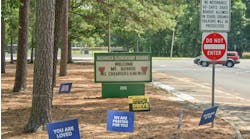As the noted philosophers Mick Jagger and Keith Richards have pointed out, “You can't always get what you want.”
It's a familiar tune for school and university administrators as they try to bridge the gap between facility needs on their campuses and funds available to address those needs. The wish lists for improvements, expansions and renovations at most education institutions far surpass what those paying the bills — boards, legislatures, taxpayers — are willing to pay.
So education design teams can't afford to spend cavalierly. They have to do the legwork to make sure the projects chosen are the ones with the highest priority and the greatest benefits; they have to make sure budgets for the projects are devoid of frills and waste; and they have to communicate the choices and rationale behind them so that all those affected accept and support the decisions.
It's not always easy.
“It's like trying to get a size 9 foot into a size 8 shoe,” says John Cannon, senior associate in the Science + Technology group at HOK, an architecture firm.
But through careful planning and hard work at the outset, design teams can transform a size 9 project so it slides comfortably into a size 8 space with an affordable price tag.
By designing and building smarter, more-efficient facilities; by finding partners to help share costs and expand the use of facilities; and by reaching consensus among all stakeholders that a facilities project is worthwhile; education officials just might find they'll get what they need.
Long-term thinking
It's rare, if not impossible, to find a school or a university that says it has plenty of money to have all the facilities and programs it wants. Administrators always have labored to find ways to squeeze more value out of their limited budgets. But in recent years, more educators and administrators have been looking at their spending decisions from a long-term perspective.
In the 1950s and 1960s, schools responding to the baby boom thought they could get the most bang for their buck by building facilities quickly and cheaply. Those schools served their primary purpose — they provided badly needed classroom space to accommodate the nation's burgeoning student enrollment.
But those facilities began to deteriorate as they reached middle age, and administrators realized that while constructing facilities quickly and cheaply and deferring maintenance may save money at first, it ends up costing more in the long run.
Planning education facilities for the long term has led many schools and universities to adopt different spending philosophies as they strive to stretch their budgets. Administrators look at costs over the life of a project, not just the price of design and construction.
Throughout the nation, education institutions have embraced sustainable design principles and practices that enable them to use resources more efficiently and save money over the life of a facility. These green principles also encourage schools and universities to take into account how their facilities and operations affect the environment beyond their campuses.
One way for schools to affect their environment positively is by reaching out to the communities that surround them, and sharing their resources and facilities with neighbors.
For the whole town
Taxpayers, especially those without any school-age children, might raise their eyebrows about footing the bill for a new $43 million high school. But the whole community of Hudson, Mass., north of Boston, has embraced the new facility that opened in 2003.
In addition to its main function as a high school, the facility also serves as a recreation center, daycare center and community center.
“It's the main public facility for the whole town,” says school superintendent Sheldon Berman. “It ended up being better than I thought it would be.”
The facility includes a daycare center, a conference center and other meeting rooms for business and community groups, an 800-seat auditorium and a 200-seat mini-theater that can be used by local arts and music groups. Community sports programs use the athletic fields and recreation facilities, and a mezzanine-level track is open in the morning and evening before and after classes for senior citizens and others in the community for walking exercise. The school's computer lab is open to the community in the evening.
By having the school welcome and embrace the entire town of Hudson, students learn about the importance of creating a sense of community and the school's role in that process.
To build the consensus needed to win community-wide approval for a new high school, school officials reached out to key stakeholders early in the planning process and involved them in deciding what would be included in the school.
“We had representatives of practically every board in town — the school committee, finance committee, parks and recreation, planning board, arts alliance,” says Berman. “We had everybody there.”
What has helped make the school-community partnership a success, Berman says, is that the community and school came together early in the process and had a clear idea of their interrelated roles.
“We had a clarity of vision about our education mission and its larger impact on the community,” he says.
The high school received the 2005 Richard W. Riley Award for Excellence from the KnowledgeWorks Foundation for its efforts at making the facility a center of the community.
“From the curriculum, to the design of the school facility, all is focused on fostering responsibility and building community in Hudson,” the foundation states.
Painstaking planning
At Truman State University in Kirksville, Mo., the growth in demand for science classes prompted school officials in the 1990s to begin planning an upgrade and consolidate their science facilities under one roof. Officials decided to renovate the building that housed the biology and chemistry departments and build an addition that would enable the physics agricultural science departments to move from elsewhere on campus. As planning progressed, the school determined that the initial design was too expensive for the available budget. The architecture firm HOK worked with university planners and decided on a mix of renovated space and a new addition.
“Originally, the school was going to gut two buildings and put up an addition,” says HOK's Cannon. “One was from the 1960s, and one was from the 1950s. After looking at it, we decided that the building from the 1950s was outmoded and out-of-date, but the infrastructure in the other building was new enough that it made sense to keep it and work around it.”
When the project was completed in 2005, the expanded and renovated facility, dubbed Magruder Hall, encompassed 147,000 square feet — about double the size of the original space. But getting to the finish line with enough money to spare “was a painstaking process,” Cannon says.
To conserve funds, the design team strived to preserve and re-use virtually all the equipment from the old science facility.
“We reused a lot of the existing casework and tried to find a place for every single piece of lab equipment,” says Cannon. “We had to map out where it all could go, like a mix-and-match puzzle.”
Putting all the science departments in one building gave Truman State the opportunity to use the lab and classroom space more efficiently. Budget limitations demanded it. The university couldn't afford classrooms and labs that sat empty much of the day. Departments accustomed to operating autonomously had to be persuaded to share.
“They didn't necessarily talk with each other,” says Cannon. “There were things that we had to talk through. We forced the departments to talk to one another. If a lab was being used only six hours a week, we could match it up with another course that could use the same facility. Instead of each researcher having his or her own lab space, a lab could house two or three researchers. And they could share equipment.”
Getting the most out of the budget also influenced the design of the corridors. “Very little space is dedicated just for circulation,” Cannon says. “We've put in coffee and gathering spots where faculty and students can intermix and get to know one another.”
The renovation of the existing building and the construction of the addition were accomplished in phases so the university could use available space while construction was progressing.
Kennedy, staff writer, can be reached at [email protected].
Sustaining savings
Some may look at sustainable design strategies primarily as an ecological effort to help preserve the environment. But many sustainable design practices have a benefit more appealing to schools and universities — saving money. In some cases, costs for carrying sustainable practices will be higher at the outset, but savings will accrue because the systems perform more efficiently.
Some examples: High-efficiency heating and cooling equipment will cut energy costs significantly over the life of a building. Well-designed windows that bring daylight into a building and keep heat or cold from entering also will cut energy costs. Lighting systems that use high-efficiency bulbs and adjust to varying light conditions will conserve electricity.
Solar energy and cool roofs can reduce a school's dependence on other energy sources. Systems that conserve water, such as low-flow toilets or no-water urinals, cut water costs. Some systems can recycle graywater used on a campus and redirect it to irrigate the campus landscape.
Other ways that education institutions can use their construction dollars efficiently:
- Commissioning
This process tests the building systems in an education facility to ensure they are designed and installed properly. The Collaborative for High Performance Schools “Best Practices Manual” says that the systems for which commissioning is essential include energy-management systems, electrical and lighting systems, fire and life-safety systems, air- and water-delivery systems, and the building envelope.
- Prototypes
School districts that are growing rapidly may need to build many facilities in a short period of time. Using a prototype design for several buildings can save money and time.

